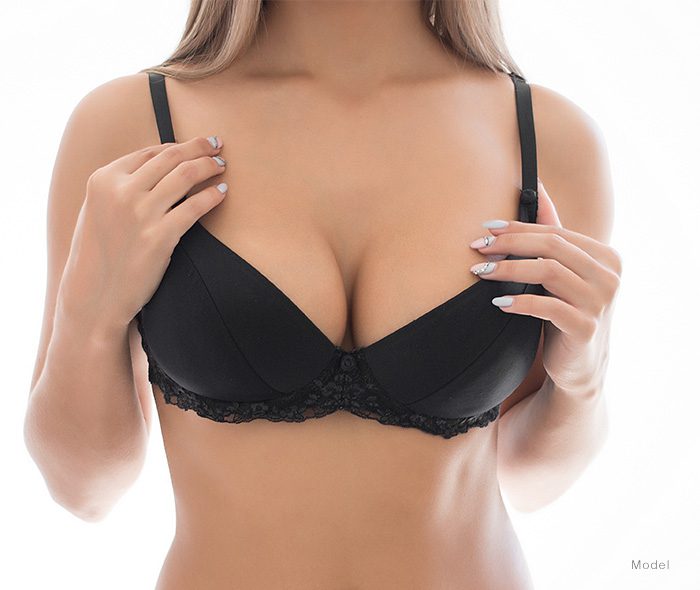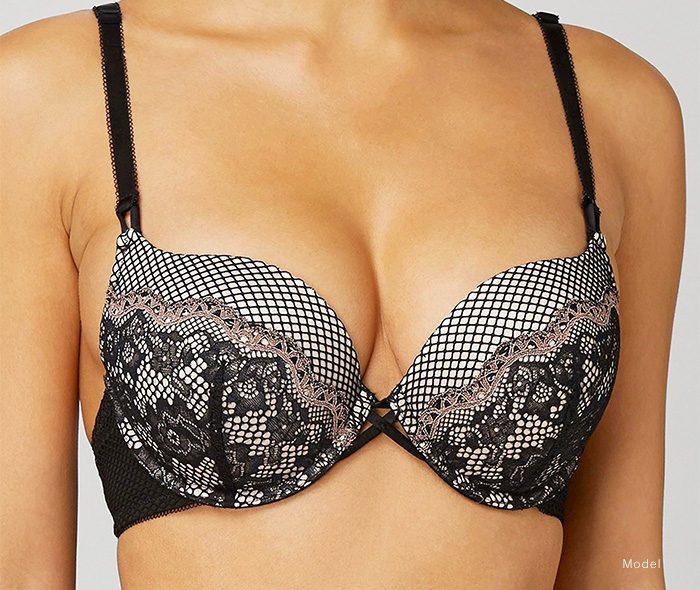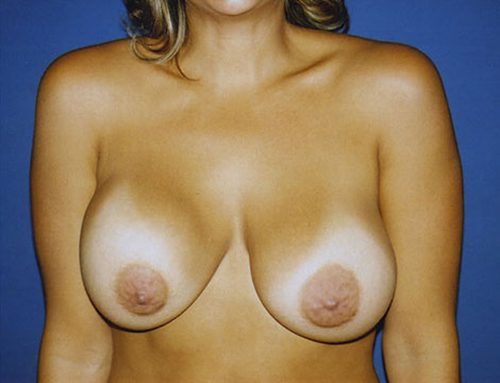Secondary Breast Augmentation in Weston, Florida
Breast augmentation remains consistently one of the most popular cosmetic surgery procedures among women. Its ability to enhance underdeveloped breasts, restore breasts that have lost shape and volume after childbirth or weight loss, or correct breast asymmetry and position can help women feel more confident and attractive. While this procedure is extremely safe and has a low incidence of complications, there are times when additional surgery is necessary. Secondary breast augmentation can improve the position of a breast implant, adjust the capsule or pocket, and enhance breast shape to produce an attractive, natural appearance for the breasts.
What Can Secondary Breast Augmentation Correct?
Capsular Contracture
After breast augmentation, a biological capsule forms around each implant. The capsule is a fibrous membrane that should be thin and pliable, allowing the implant to feel soft in the breast. If in rare cases, the capsule thickens and constricts due to inflammation or for other reasons, it is called capsular contracture. Symptoms of capsular contracture include a firm-feeling breast, pain, coldness, and visible distortion with malposition of the implant and breast asymmetry. Secondary breast augmentation uses various techniques to repair capsular contracture, replace the implant, and restore the breasts.
Implant Rupture or Rippling
One minor risk with breast implants is that they may rupture or ripple. If the shell of the implant is compromised, it will rupture or deflate. An MRI scan is often required for the accurate detection of ruptured silicone implants. Deflated saline implants, on the other hand, cause an instantly noticeable change in breast fullness because the harmless saline solution quickly leaks out into the body. Resolution through secondary surgery will replace the compromised implant with a new, intact implant. Implant rippling, which can also occur, may be resolved by converting the implant to submuscular placement or using an acellular dermal matrix, fat transfer, or other strategies.
Bottoming Out
Breast implants may occasionally sink in their position on the breast wall. Sometimes one or both implants sink excessively due to weak structural support, even to the point of slipping below the inframammary crease. This condition is known as bottoming out. Secondary breast augmentation can correct bottoming out by improving the pocket and structural support for the implant, often with plication and suturing with or without an acellular dermal matrix.
Double Bubble Deformity
Infrequently, a breast implant may shift upward or downward on the chest wall and create an unusual breast appearance known as double bubble deformity. If the implant migrates upward, a noticeable bubble may form where the implant rests, and a secondary bubble of breast tissue may appear to hang off the implant. If the implant slides downward, a bubble of breast tissue may appear to sit on top of a secondary bubble where the implant lies. Reparation of the breast pocket will correct double bubble and resituate the implant in its rightful place to restore a more natural appearance.
Implant Malposition or Displacement
Infrequently, shifting of the implants may occur. This is most often because of poorly chosen implants and as the result of poor surgical technique. One or both breast implants may become displaced, either too close to the middle (symmastia), too low (bottoming out or double bubble deformity), too high (double bubble deformity), or too far to the side (toward the underarm). The surgeon will create a new breast pocket and adjust the implant capsule to hold it in place and reduce the risk of shifting.
Implant Size or Style
In some cases, women have not had any surgical complications but are dissatisfied with their current implants and how their breasts look and feel. Secondary breast augmentation can exchange the old implants with new implants of a different size and/or style. Dr. Messa will help you make an educated decision about which implant type and size will be the most likely to give you the results you desire.
What Do You Desire?

Correction of Complications
Complications such as those described above are infrequent and not guaranteed to occur. However, when they do happen, they often cause cosmetic issues and occasionally physical discomfort or concerns. Any surgical complications after breast augmentation can and should be corrected with secondary breast augmentation. This procedure can eliminate the problem and improve the appearance of the breasts.

A Change in Implants
If you’re interested in a change, secondary breast augmentation can exchange your breast implants for you. Whether you wish to change implant sizes or types, this procedure can give you the new look you desire. Dr. Messa will adjust the breast pockets as necessary to ensure that the new implant size or style will be well supported and natural in appearance.

A More Youthful Look
Overly large breast implants can sometimes cause accelerated breast sagging. This may cause you to look older than you feel and are. Secondary breast augmentation is an opportunity to exchange your implants, downsize if you desire, and even get a breast lift to recreate a youthful breast appearance.
Addressing Your Concerns
Recovery
After your secondary breast augmentation, you may experience some swelling and bruising. Depending on the techniques used for your procedure, you may also feel tightness or pressure for the first few days. A compression garment may be provided to minimize swelling and hold your breasts in position as they heal. You should plan to take at least one week (possibly two) off from work so that you will have time to recover. After your initial augmentation surgery, you may resume light physical activities two weeks later but should postpone strenuous activities for approximately four weeks. Major swelling should subside by six weeks after the procedure.
Scars
The surgical techniques used for your secondary breast augmentation may leave some scarring. However, in many cases, the surgeon can disguise scarring by placing the incision in the same location as was used for the initial augmentation procedure. How your body heals will be the key determining factor in the appearance of any scarring. Most incision scars are likely to fade over time.
Cost
The cost of secondary breast augmentation varies per patient because the procedure is highly customized. Influencing factors include surgical fees, facility fees, anesthesia fees, implant type, location, and medications. Dr. Messa will ensure that your procedure is catered to meet your needs, and this will be reflected in the cost of your treatment plan.
Pain
Some discomfort, soreness, and pressure can occur after secondary breast augmentation. Prescribed medications will alleviate any discomfort until it subsides naturally. The compression garment will assist in minimizing swelling, which can also help to reduce discomfort during recovery.
Frequently Asked Questions
-
WHAT TYPE OF ANESTHESIA IS USED FOR SECONDARY BREAST AUGMENTATION?
General anesthesia is used for secondary breast augmentation to ensure patient safety and comfort.
-
HOW DO I KNOW IF I NEED A SECONDARY BREAST AUGMENTATION?
Individuals who need correction of surgical complications associated with their breast implants are candidates for secondary breast augmentation. Likewise, patients who wish to exchange their implants for a different size or style may be candidates for secondary breast augmentation. If you are not sure whether you should undergo this procedure, schedule your complimentary consultation, and Dr. Messa will evaluate your situation to determine whether you are a candidate.
-
WHEN SHOULD I GET A SECONDARY BREAST AUGMENTATION?
Secondary breast augmentation should be performed as soon as possible to correct surgical complications (e.g., capsular contracture, implant rupture, and bottoming out). If you would like to have your implants exchanged for aesthetic reasons, it can be appropriate to undergo secondary breast augmentation as soon as you desire it and are in good physical condition for surgery.
-
WHAT TECHNIQUE WILL BE USED FOR MY PROCEDURE?
Techniques for secondary breast augmentation vary widely depending on the reason for undergoing the procedure. A capsulectomy, or removal of the capsule and subsequent replacement of the implant, is commonly performed to repair capsular contracture. A capsulorrhaphy, or plication with or without an acellular dermal matrix, can correct implant displacement or malposition that has caused issues such as double bubble deformity, symmastia, or bottoming out. Modification of the pocket will be required when changing implant sizes or styles. The surgeon may create a new breast pocket, use suturing techniques to improve structural support, and even remove breast tissue and skin to improve the position of the implants and the appearance of the breasts. The procedure is individualized based on the patient’s clinical appearance and anatomy. The details of your procedure will be determined after your consultation with Dr. Messa.
-
HOW LONG WILL THE RESULTS LAST?
The results of secondary breast augmentation are often long lasting, and most patients will be able to enjoy their new implants and results for many years to come. However, for a small percentage of patients who experience capsular contracture or similar complications, the risk of recurrence is slightly raised. Dr. Messa takes great care to reduce the risk of recurrence as much as possible, but many factors dealing with a patient’s ability to heal are unpredictable. Additional corrective surgery can be performed whenever necessary to restore beautiful and healthy breasts.









